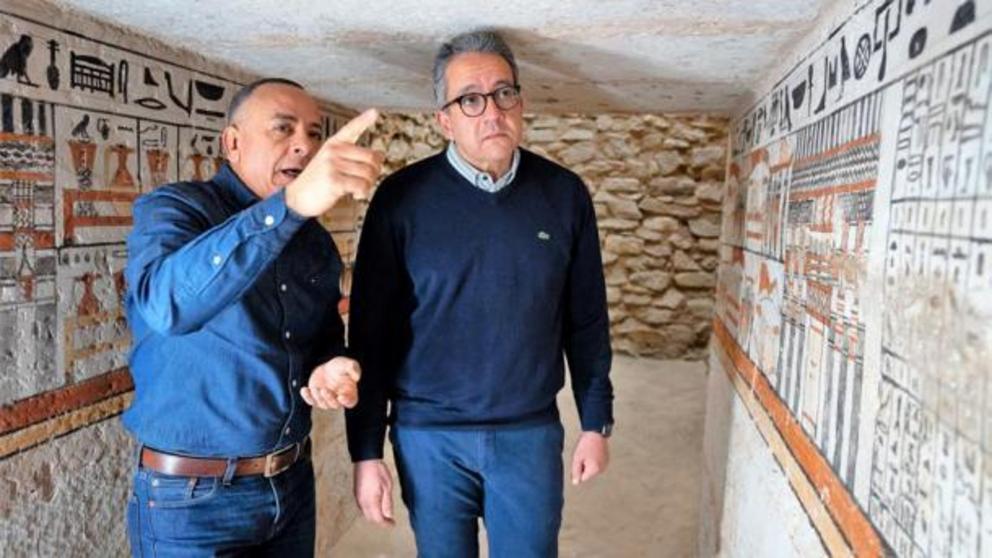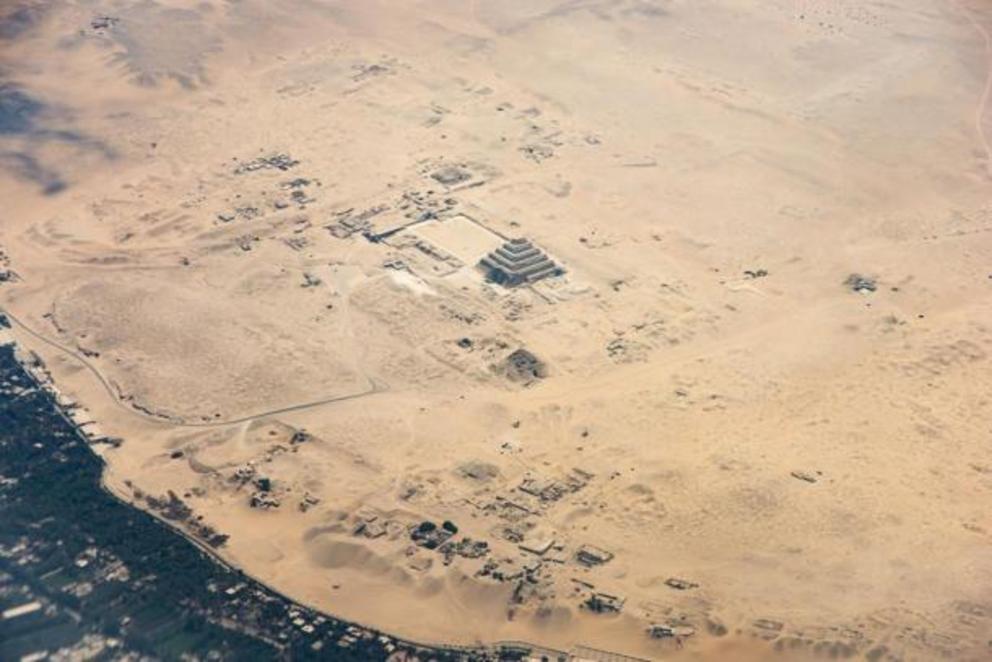Excavations unearth five stunning 4000-year-old tombs in Egypt
Top image: Minister of Tourism and Antiquities, Dr. Khaled El-Enany, visiting the newly discovered tombs in Egypt.
The Egyptian Ministry of Tourism and Antiquities announced another discovery in Saqqara, the necropolis of the erstwhile capital of the ancient Egyptian empire, Memphis. Ongoing excavations revealed the discovery of five carved tombs in Egypt, with many burials and archaeological finds from the Old Kingdom (c. 2700-2200 BC) and the First Transition/Intermediate Period (2181–2055 BC), roughly 4,700 and 4,000 years ago, reports Xinhua News Agency .
“The Egyptian archaeological mission uncovered five tombs about 100 meters (328 ft) northwest of the Merenre Pyramid in southern Saqqara,” the Ministry said in a statement, a copy of which was contained in an announcement on Facebook on Thursday 17th March. Dr. Mustafa Waziri, the General Secretary of the Supreme Council of Antiquities, explained that the five tombs, which belonged to top officials and dignitaries from the respective time periods, are in a state of good preservation.
Minister of Tourism and Antiquities, Dr. Khaled El-Enany, was photographed with Dr. Mustafa Waziri viewing the five inscribed tombs from the two periods. Incidentally, Old Kingdom is the time period in Egypt associated with pyramid building , most famously the Step Pyramid . The decision to establish Saqqara as the official royal necropolis was made under King Djoser (c. 2686-2648 BC), the first king of the Third Dynasty of the Old Kingdom .
 Minister of Tourism and Antiquities, Dr. Khaled El-Enany, visiting the newly discovered tombs in Egypt.
Minister of Tourism and Antiquities, Dr. Khaled El-Enany, visiting the newly discovered tombs in Egypt.
Five Senior Court Officials and their Tombs in Egypt
The first cemetery from the discovered graves belonged to a person named Irie, one of the top nobles of the court. The tomb included a well-defined pathway leading to the burial room , with walls adorned with engraved pictures of many funeral scenes. These incorporate views of the tables of the cemeteries, the front of the palace, and pots with many essential oils. There is huge limestone coffin as well as engraved artifacts.
Grave number two belonged to the wife of a man named Yart, an aspect deciphered by the proximity of her grave to his. This one also includes a rectangular shaft. Meanwhile, grave number three belonged to a person called Babi Farhafai, also called Bi Nafarhafayi, who used to occupy several important court positions, namely supervisor of the Great House, the chanting priest, and the cleaner of the house.
 Minister of Tourism and Antiquities, Dr. Khaled El-Enany, with Dr. Mustafa Waziri viewing the five inscribed tombs during a visit to the newly discovered tombs in Egypt.
Minister of Tourism and Antiquities, Dr. Khaled El-Enany, with Dr. Mustafa Waziri viewing the five inscribed tombs during a visit to the newly discovered tombs in Egypt.
The fourth grave is, interestingly, a well discovered six meters (19.6 feet) underground belonged to a woman called Betty, who was responsible for the king’s makeup, appearance, and dressing. Allegedly, she was a priestess of Hathor, goddess of love, beauty, music, dancing, fertility, and pleasure. Her role of idolatry is mentioned in a few sources of the time.
Fifth cemetery is a man called Hannu. This tomb in Egypt also consists of a rectangular shaft, that is a 7 meter (22.9 feet) rectangular shaft. Hannu too had many titles and roles which included supervisor of the royal palace, mayor, supervisor of the Great House, bearer of the seals of Lower Egypt, and supervisor of an orchard, reports Cairo Scene .
 The Saqqara necropolis, seen here, has become a hub of discoveries in the past few years.
The Saqqara necropolis, seen here, has become a hub of discoveries in the past few years.
Saqqara: The Divine Energy of Burials and Tombs in Egypt
Saqqara has become a hub of discoveries in the past few years, with hundreds of colored coffins with preserved mummies of senior officials, priests, and other notables from the 26th Dynasty (or the Saite dynasty period, i.e., 664 to 525 BC) found, says the same statement by the Ministry of Tourism and Antiquities. In 2020, after the discovery of 100 human sealed coffins, and 40 grand statutes, Zahi Hawass, an Egyptologist and former Minister of State for Antiquity Affairs had remarked , that “this discovery is very important because it proves that Saqqara was the main burial of the 26th Dynasty.”
Saqqara was not just a location for burying human beings though. In 2011, 8 million animal mummies were uncovered next to the Temple of Anubis, the god of death and mummification. “ Saqqara would have been the place to be seen dead in. It had this numinous, divine energy that would help you get into the afterlife,” said Campbell Price of the Manchester Museum, who was quoted by Smitshonian Mag in a report from 2021 that perfectly sums up the spiritual and cultural importance of Saqqara’s pyramids. Price had been working on the site for many years.
After all, the necropolis had historically been a hub for religious cults, and subsequent burials, starting with low, flat roofed tombs called mastabas. Under Pharaoh Psamtik of the Saites, who ruled between 664 and 610 BC, traditional rituals and beliefs were sought to be revived by him, and this put Saqqara back into the spotlight. It exploded in popularity and became a pilgrimage site, an “ancient Mecca or Lourdes.” Pilgrims began competing and vying for spaces, which would be contested often through social status and connection to the king.
In a press conference slated for Saturday, we are likely to learn more about this mystical burial paradise at Saqqara. Egypt’s Tourism Ministry has become especially active in the last decade, so we are sure to learn more and more about one of ancient history’s most advanced civilizations and their tombs in Egypt.

